Abernathy offers publishers a three-pronged strategy
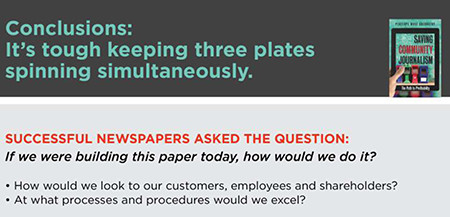
While saying she understands the imperative newspapers feel to protect the print edition, Penelope Muse Abernathy, Knight Chair in Journalism and Digital Media Economics at the University of North Carolina, told publishers at the News Industry Summit that they need to be realistic. She outlined a strategy that she said would help them remain relevant and, therefore, profitable in the digital age.
Abernathy, author of the book "Saving Community Journalism: The Path to Profitability," defines community journalism – not by the circulation size of the paper – but by mission. Her definition includes all but about 90 of the largest newspapers in the country (three national newspapers and 87 metro and regional newspapers).
Her book is based on a study conducted among 12 community newspapers, ranging in size from a 7,000-circulation weekly to the 90,000-circulation Deseret News. During lots of talks with readers and advertisers of these newspapers, Abernathy identified key things that both groups are seeking.
Readers said newspapers:
- Help them identify main issues that they need to care about.
- Help them know how to live life better.
- Give them a sense of social and political identity.
Advertisers want newspapers to help them connect with consumers and bring feet through their doors.
She said surveys showed newspapers' current readers are very loyal, but their habits are changing quickly – as are the habits of those who are not loyal readers. And, she said: "Your advertisers are even more confused than your sales staff. They are confused and they are searching. The good news is that they will look to you for some answers."
She also said she is always stunned at the number of readers who have no idea that newspapers are having any trouble.
She told publishers at the News Industry Summit that it is critical that community newspapers survive, saying they historically have:
- Set the agenda for debate of public policy issues.
- Encouraged regional economic growth and development.
- Fostered a sense of geographic identity.
She suggested a three-pronged approach:
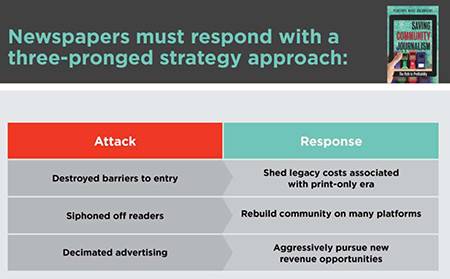 |
Typically, when businesses face disruption, businesses attack the problem on the cost side. But, since newspapers have never made most of their money from readers – rather by selling audience, she said that turns around what newspapers need to do.
She posed several important questions for publishers to consider:
- What do you know about how fast your readers' media habits are changing?
- What are you doing to prepare your readers for the day when their daily newspaper is only printed three times a week?
- What are you trying to accomplish with your paywall?
As legacy costs are shed, she emphasized focusing on the value drivers of the future: content creation and aggregation.
As an example, she cited the fact that obituaries often are the second or third best-read feature that newspapers have in the paper. She suggested that newspapers compare that with the fact that many print-only readers are over the age of 60. "What can you do," she asked to entice those readers to start sampling you online? She encouraged newspapers to start breaking out the obits in the same way that funeral homes are doing, and allowing for tributes, for example. "People over the age of 60 said they might think of going online for something that allowed them to do that," she said. "So, think about how you can begin to start enhancing your content online. That begins to help the people who are your loyal print readers make the transition."
In six of the markets that she surveyed, she found that roughly half of the people who read the paper online do not read a print edition. "That's very different than what was shown even five years ago," Abernathy said.
Newspapers' most loyal readers, she said, are the other 50 percent who consume newspapers both in print and online and they want the content to be complementary – not the same.
During this time of transition, Abernathy said we are learning some important things about readers. She said she heard Tom Rosenthiel of the American Press Institute speak at a recent conference of the American Society of News Editors. At that conference he said:
- Technology is a behavior, not an audience.
- The news cycle is asynchronous, not continuous.
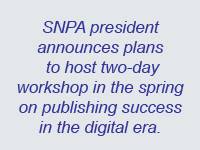 |
Building loyal community online:
Abenathy said newspapers' most loyal audiences are the print + online readers. The next most loyal are "print only," with "digital only" being the least loyal.
She asked her audience in Charlottesville:
- How many of your current readers are loyal?
- Why are they loyal?
- What do they care about?
And, she offered a simple test to help determine the answers. She suggested surveying your readership – at least once a year – and asking, on a scale of one to 10, with 10 being the highest, whether readers would recommend the paper to a friend or a colleague. Only count the nines and 10s, she said – and view everything under a six as a detractor.
By adding an additional seven or eight questions, newspapers can use this to see how fast media habits are changing in the market.
As to why they are loyal, she said: "People are loyal to newspapers that they feel are the most credible and comprehensive source of news and information that they care about. Of those three Cs, the most important is 'care about.' So you need to figure out what actually makes them tick."
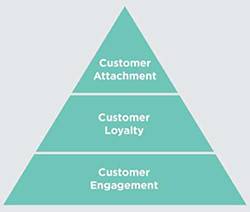 |
As long as you understand your loyal readers, she said, you can continue to provide what they care about. That way, you won't alienate them while you are adding extra things that can also help you attract a new audience.
Abernathy also noted that newspaper executives often talk about customer engagement. She looks at that as the "bare level of interaction," and encouraged newspaper staffs to work on moving up the brand ladder toward customer loyalty and customer attachment.
As they pursue new revenue, Abernathy posed three more questions for publishers to ask themselves:
- What is the story your advertising sales reps are telling about your readers?
- How well is your advertising serving the needs of the advertisers?
- How well can your sales team sell across multiple platforms?
She warned that, if ad sales reps are offering nothing about readers, it leaves competitors to tell the story. And, what they are saying, Abernathy said, "is that newspaper readers are over 60, they are old and they are dying off one-by-one. They are not hearing any of the good stuff about your readers who are patronizing their businesses and who are in the bull's-eye of where they need to be aiming their message."
So, what do your advertisers need, she asked? "They need simplicity," she said. "They need somebody they can trust who's credible. What we found over and over again is advertisers want to believe in the paper because they usually know the advertising reps. But, what they're not getting is any advice" – other than how to buy a print ad in the paper or a suggestion to try some digital thing.
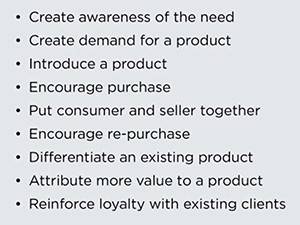 |
She also spoke of the interactivity of the Internet, saying there has been a merger of the concepts of advertising and marketing. In response to this same publisher, she said, "Increasingly advertisers we talked with (even in very small communities) no longer distinguish between marketing and advertising dollars. That's one reason a newspaper ad staff needs to adopt the 'paid, earned, owned' mindset (see graphic below) and help advertisers maximize their return on advertising dollars across the various mediums. That's also another reason to consider setting up an in-house digital ad agency so the newspaper can charge a consulting fee for this placement outside the newspapers' various products. Properly done, and correctly sized to the market you are serving, that can be another source of additional 'advertising' revenue for newspapers – plus it helps the advertising staff learn to better serve your advertisers and it establishes your paper as the local expert on all forms of advertising and marketing."
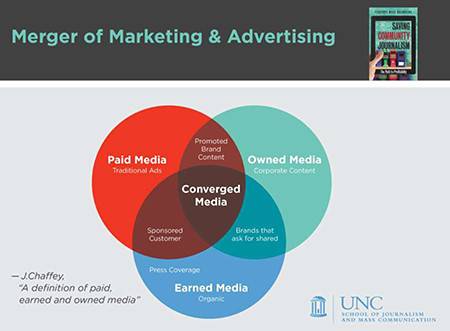 |
At the News Industry Summit, Abernathy also encouraged publishers to visit her website: www.savingcommunityjournalism.com. It offers:
- Lessons that focus on setting up a strategy and measuring results.
- A case study featuring The News Reporter of Whiteville, N.C.
- A Staying Up-to-Date section.
- And, a Learn More section, filled with additional materials.
"In the end," Abernathy said, "it's really about storytelling. It's what newspapers do really well. What is the story your community will be telling about you 10 years from now? What is the story you want your community to tell about you 10 years from now?"






